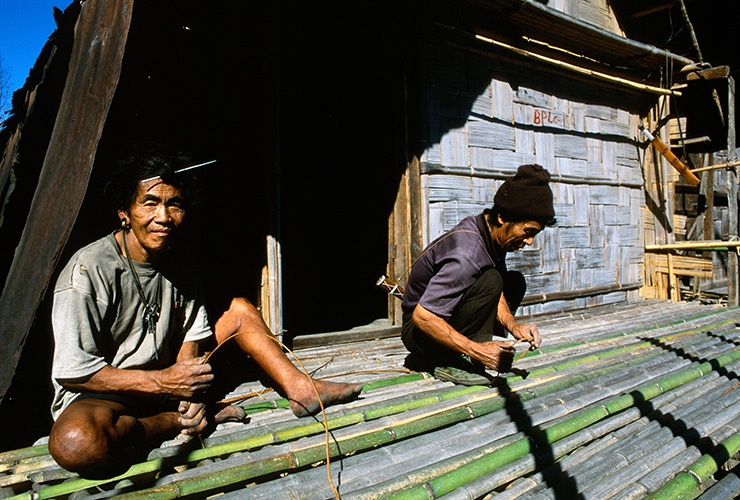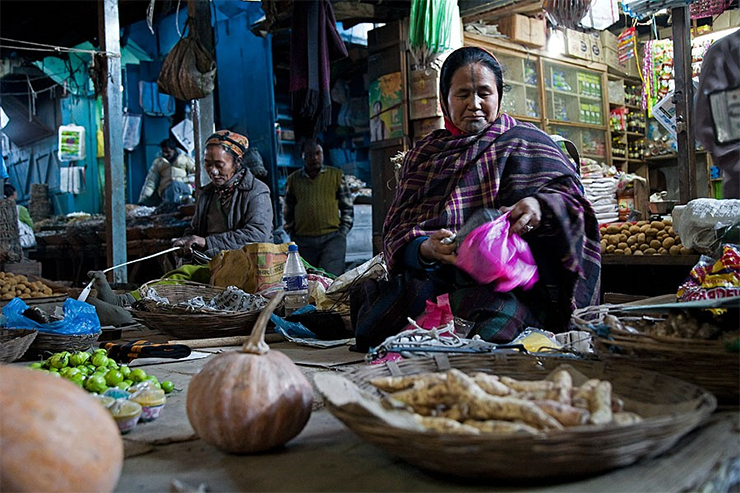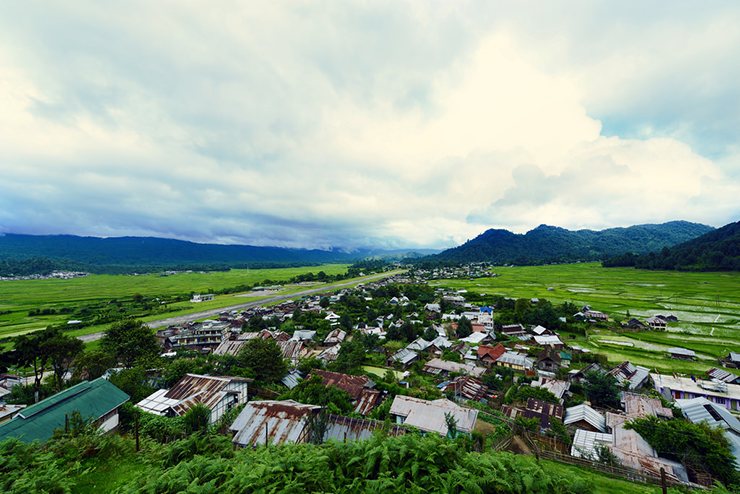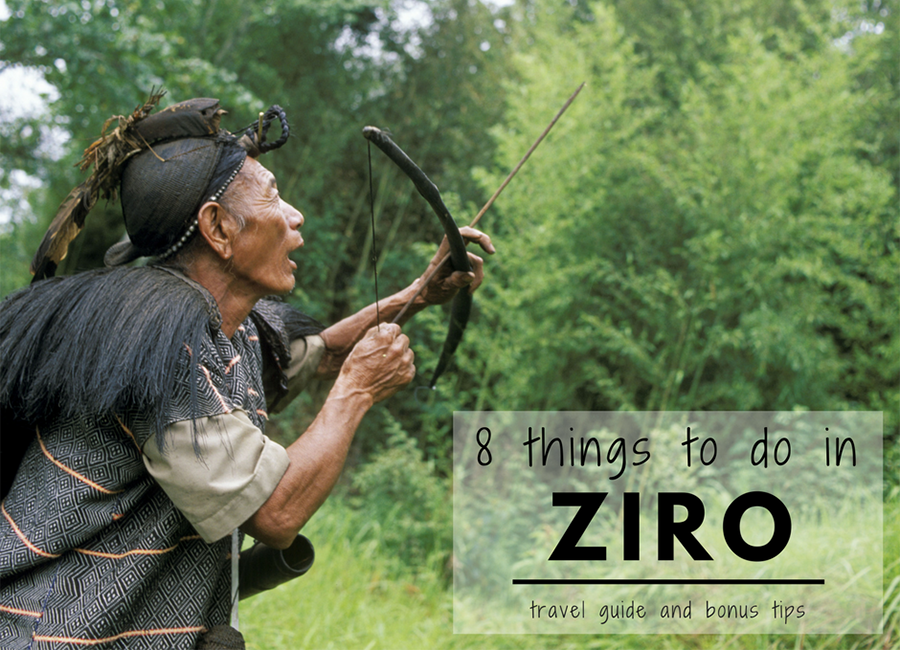Ziro is a beautiful valley in the lush subtropical mountains of central Arunachal Pradesh. It is located in Lower Subansiri District and is situated at an elevation of 1700 meters. Ziro is the home of the indigenous Apatani tribepeople, who have rich cultural traditions and are also scientifically advanced than other ethnic groups of the state. The Apatanis are a tribe of mongoloid origin and are culturally akin to the neighboring Tagin, Nyishi, Adi and Galo tribes, who all belong to the Tani group as they believe to have descended from the same ancestor Abotani. The valley is named after the Ziro clan, who were the first Apatanis to settle in the region. Ziro valley has been listed for nomination as an UNESCO world heritage site for its unique culture and the sustainable practices. Travelers have started visiting the valley to see the fascinating culture of the Aptani tribe, especially the women who are well documented for their facial tattoos and large nose plugs. Hapoli, or Hao polya in the native dialect meaning plateau, is the main town and commercial centre in the valley.
Here is our expert advice on the sights to see, activities to do and the secrets in and around Ziro Valley

1. Apatani villages such as Hong, Hari, Bula, Baro and Siiro are best to experience the indigenous culture of the Apatani people. Names of the villages represent the clan or the sons of Abotani. The villages still have traditional wooden houses built on stilts. Most villages are compact with houses built close to each other as the Apatanis often faced raids from the fierce neighboring tribes. The Lapan is a platform at the centre of every village which serves as the point of gathering for all occasions. Tall Babo totem poles can be also seen in front of most houses which signify the number of family members. One can explore by walking through the villages on guided tours, visit homes and interact with the old Apatani villagers who still have tattooed faces and nose plugs, listening to fascinating stories of bygone years when their society had not been influenced by modernity. You may also come across an animist ceremony if lucky, getting a chance to observe their mystic traditions.

2. Rice farms are an integral part of the landscape which adds more beauty to the valley. The terraced rice fields are organic as many farmers continue the old practice of traditional farming techniques. Women are mainly are seen working in the farms as men go off to the forests gathering timber and bamboo. One can walk through the farms and the little granaries wading through the criss-crossing streams. The farms are unique as they also rear fish and other daily-use vegetables. The Apatanis have permaculture rooted into their traditions and sustainable practices such as using organic waste as fertilizers is common.

3. Tarin fish farm is a high altitude fishery. Fishes of high altitude are bred in the ponds here, whose fingerlings are later sold to farmers during paddy cultivation season. In this way, the Apatanis can raise both rice and Ngihi fishes together in their fields. It is interesting to observe the fish and rice cultivation techniques used by the Apatani tribe for optimum use of their available land resources.

4. Hapoli market is an interesting place to see unusual items that are a part of the local cuisine. Dried rats, frogs, meat steaks, ferns, Tapyo salt, bamboo shoots and a variety of local herbs can be seen in the stalls. Vendors selling handmade items of cane and bamboo are also available in the market as such tools are used by the villagers for their daily domestic use. Most items are packed in leaves and people carry them off in wicker baskets.
5. District Museum at Hapoli Library is a relatively new attraction in Ziro. It showcases the cultural artefacts of the Apatani people and has small collection of old and rare photographs. The anthropological collection provides a good insight to the diverse tribal cultures of Arunachal Pradesh. It is also a good source of information for the culture enthusiasts.

6. Ziro Puto Viewpoint is a little hillock located near the airstrip. It offers a bird eye view of the beautiful countryside of Old Ziro town below which is surrounded by evergreen forests, terraced rice farms and misty mountains. After experiencing the cultural highlights of Ziro, one can rest here and enjoy the nature.
7. Donyi Polo shrine is a place worship of the Apatani people. The Apatanis follow the indigenous religion of Donyi Polo in which they worship Donyi, the sun and Polo, the moon along with their ancestor Abotani. Villagers gather for mass prayers on Sundays. Large temples are in Hija, Hong and Hari villages, small Nebu shrines or bamboo huts are near every village where the Shaman priests foresee prophecies.

8. Homestays facilities for travelers have come up in the recent years, allowing us to get an intimate interaction with the Apatanis and partaking in responsible tourism. Sitting by the family fire in cold nights, sipping on local tea and hearing fascinating stories from newfound friends result in the fondest of memories.
Bonus Tips
Most travelers usually spend two full days at Ziro after spending hours of travel through the mountain roads to reach Hapoli. For those visitors spending few extra days also have some lesser known places to explore in the valley. One can hike through bamboo groves and pine farms which are located around every village. Apatanis preserve their forests for the natural resources and their dependence on nature.
Talley Valley Sanctuary near Ziro is a biodiversity hotspot where camping can be arranged; it has a variety of rhododendrons, reptiles and orchids in its coniferous forests. The unique biodiversity of this habitat has attracted numerous environmentalists such as Dr. Gerry Martin and Sandesh Kadur.
Kile Pakho is a viewpoint in the outskirts from where one can see the Himalayan peaks. The giant Shiva Lingam at Kardo forest is also an interesting attraction for Hindu pilgrims. Visitors can also engage themselves in volunteer travel activities such as teaching at village schools and assist local experts in butterfly monitoring and conservation.

Ziro serves as a doorway into the mystic mountains of central Arunachal Pradesh. We highly recommended travelers to continue their explorations going east towards the mighty Subansiri and Siang valleys where powerful tribes such as the Adis and Tagins live simple and sustainable lives midst very verdant scenery. Tribes of Central Arunachal Pradesh is our immersive 10 days tour into these distant lands, covering deep cultural interactions with the friendly natives, blissful landscapes and meaningful stays with host families.
Ziro Festival of Music is a hip and offbeat outdoors music festival held during September towards the end of the monsoon season. It showcases the independent music scene of the country, while also allowing travelers who come from all over to immerse in the valley’s mesmerizing culture and landscape.
When to visit?
Ziro can be visited throughout the year, but it is more enjoyable during the Myoko Festival in March where villagers indulge in community feasts and the local priests perform animistic rituals. Dree, or harvest festival is celebrated in July when one can see traditional dances along with cultural performances. It also happens during the rainy season when the landscape is almost transformed with deep lush greenery.
Seasons of the Sun!
Being located at a high altitude, weather is mostly cold throughout the year. Summer months from May to September are pleasant, 20’C during the day and 15’C at night, but with monsoon from July to mid October the valley sees a good amount of rain. The season changes to fall from mid-October to mid-November. Soon after winter sets in from November to March when the weather is cold and temperatures drop from 10’C to 0’C. Winters are ideal for traveling as days are warm, clear and sunny.
Where to stay?
Being a small town and due to its remote location, there aren’t any luxurious options for stay. Budget accommodation is available in few of the old lodges near the taxi stand at Hapoli. However, due to the growth of tourism, standard lodges have come up in the area. During the travel rush at Ziro Music Festival, the organizers also arrange tent accommodation at the festival grounds. There are also homestays available at some of the villages where one can experience authentic Apatani hospitality and understand their native culture closely.

8 responses to “8 Things to do in and around Ziro | Travel Guide”
The pictures are so lovely and beautiful. I’m definitely gonna visit this place in india very soon.
Thanks for the article. It was an interesting read.
Glad you like the article Sally. 🙂 Hope you have inspiring travels to these fascinating lands!
Thank you so much for the guide! Pictures are really unique and awe-inspiring.
Thanks Pooja! Happy to know that you liked the article and the photos
We did Ziro in March – thanks to Bornav and our Driver Anil, we had the utmost best time there. Well organized Bornav – top Pic´s
Thanks Bornav for your blog and ideas. I am visiting Ziro in September. I am sure I shall good use of your advice. Thanks again.
[…] culture and traditions are still so strong even in the 21st century. Read this Northeast India travel blog to know what all you can do in Ziro […]
[…] ver cómo su cultura y sus tradiciones siguen siendo tan fuertes incluso en el siglo XXI. Lea este blog de viajes del noreste de la India para saber qué puede hacer en el valle del […]